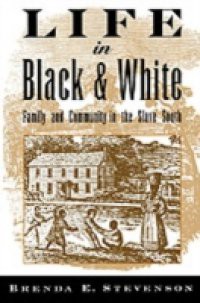Life in the old South has always fascinated Americans--whether in the mythical portrayals of the planter elite from fiction such as Gone With the Wind or in historical studies that look inside the slave cabin. Now Brenda E. Stevenson presents a reality far more gripping than popular legend, even as she challenges the conventional wisdom of academic historians. Life in Black and White provides a panoramic portrait of family and community life in and around Loudoun County, Virginia--weaving the fascinating personal stories of planters and slaves, of free blacks and poor-to-middling whites, into a powerful portrait of southern society from the mid-eighteenth century to the Civil War. Loudoun County and its vicinity encapsulated the full sweep of southern life. Here the regions most illustrious families--the Lees, Masons, Carters, Monroes, and Peytons--helped forge southern traditions and attitudes that became characteristic of the entire region while mingling with yeoman farmers of German, Scotch-Irish, and Irish descent, and free black families who lived alongside abolitionist Quakers and thousands of slaves. Stevenson brilliantly recounts their stories as she builds the complex picture of their intertwined lives, revealing how their combined histories guaranteed Loudons role in important state, regional, and national events and controversies. Both the Declaration of Independence and the U.S. Constitution, for example, were hidden at a local plantation during the War of 1812. James Monroe wrote his famous Doctrine at his Loudon estate. The area also was the birthplace of celebrated fugitive slave Daniel Dangerfield, the home of John Janney, chairman of the Virginia secession convention, a center for Underground Railroad activities, and the location of John Browns infamous 1859 raid at Harpers Ferry. In exploring the central role of the family, Brenda Stevenson offers a wealth of insight: we look into the lives of upper class women, who bore the oppressive weight of marriage and motherhood as practiced in the South and the equally burdensome roles of their husbands whose honor was tied to their ability to support and lead regardless of their personal preference; the yeoman farm familys struggle for respectability; and the marginal economic existence of free blacks and its undermining influence on their family life. Most important, Stevenson breaks new ground in her depiction of slave family life. Following the lead of historian Herbert Gutman, most scholars have accepted the idea that, like white, slaves embraced the nuclear family, both as a living reality and an ideal. Stevenson destroys this notion, showing that the harsh realities of slavery, even for those who belonged to such attentive masters as George Washington, allowed little possibility of a nuclear family. Far more important were extended kin networks and female headed households. Meticulously researched, insightful, and moving, Life in Black and White offers our most detailed portrait yet of the reality of southern life. It forever changes our understanding of family and race relations during the reign of the peculiar institution in the American South.



















